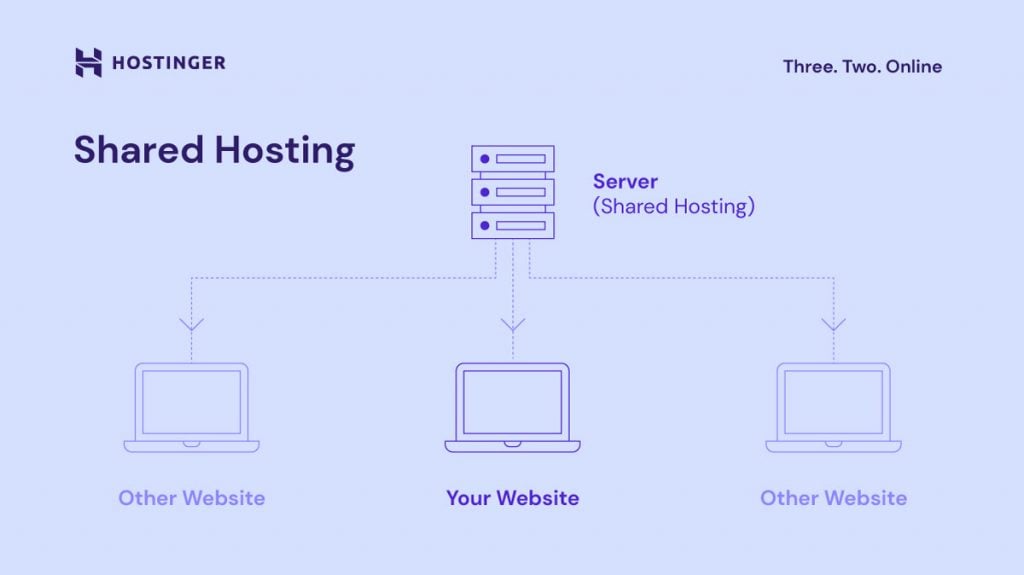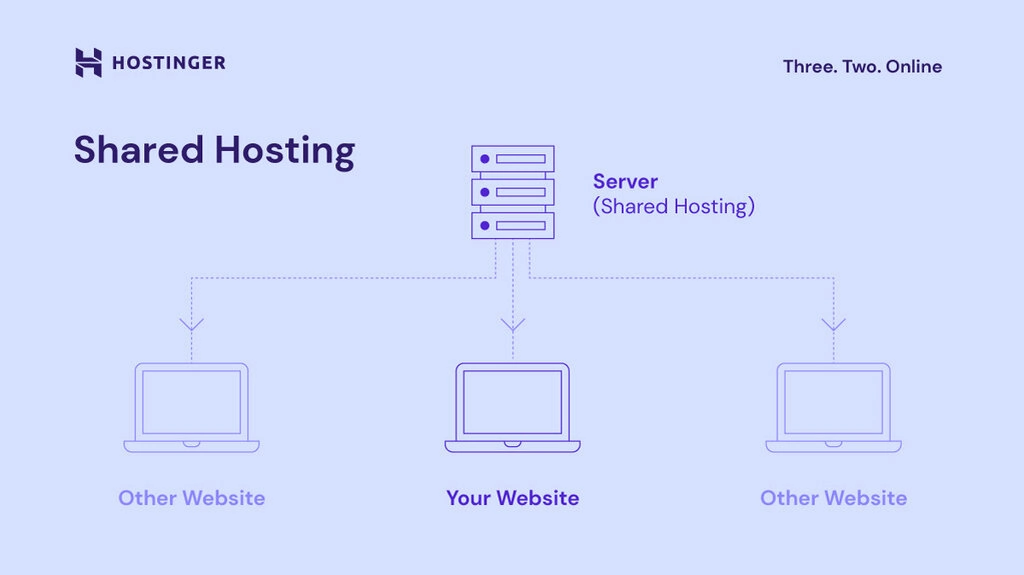Shared web hosting works by hosting multiple websites on a single server, where resources like storage and bandwidth are shared among users, offering an affordable hosting solution.
But how does it work? In shared web hosting, multiple websites share a single server’s resources. This means your site shares space, bandwidth, and memory with others. It’s like renting an apartment in a building with other tenants. This setup makes it affordable for small businesses and personal sites.
While it’s budget-friendly, it also requires you to share resources with others. This can affect your site’s performance if another site uses too many resources. Understanding how shared web hosting works helps you decide if it’s the right choice for your site. This post will explore its workings, benefits, and limitations, giving you a clear picture of shared hosting.

Credit: www.hostinger.com
Introduction To Shared Web Hosting
Shared web hosting is a popular choice for beginners. It’s cost-effective and easy to manage. This type of hosting is perfect for small websites and blogs. Let’s dive into the details and understand how it works.
What Is Shared Hosting?
Shared hosting means multiple websites share one server. Each site gets a part of the server’s resources. These include disk space, bandwidth, and memory. The host manages the server. You only focus on your website.
Think of it like renting an apartment in a building. You share the building with others. But you have your own space. This setup keeps costs down for everyone.
Why Choose Shared Hosting?
Shared hosting is affordable. It’s a great choice for those on a budget. Small businesses and personal sites can benefit from it. Here are some reasons to choose shared hosting:
- Cost-Effective: Shared hosting is cheaper than other types.
- Easy to Use: The host handles server management.
- Beginner-Friendly: No need for technical skills.
- Scalable: Upgrade to higher plans as your site grows.
Shared hosting plans often come with useful features. These include:
- Free domain registration
- Website builders
- Email accounts
- One-click installations
In shared hosting, resources are divided among users. This can affect performance during high traffic. But for low to moderate traffic, it’s a reliable solution.
Shared web hosting offers a balance between cost and convenience. It’s ideal for small websites and beginners.

Credit: stablepoint.com
Key Components
Shared web hosting is a popular and cost-effective solution. Understanding its key components can help you make an informed decision. Let’s look at these components in detail.
Server Hardware
The server hardware is the backbone of shared hosting. It includes:
- CPU: The Central Processing Unit handles all the server’s tasks.
- RAM: Random Access Memory stores temporary data for quick access.
- Storage: Hard drives or SSDs store your website files.
- Network Interface: Connects the server to the internet.
Each server hosts multiple websites. The hardware must be powerful to handle the load. Regular maintenance ensures smooth operation.
Software Environment
The software environment includes all the programs that run on the server. Key components are:
- Operating System: Most shared hosts use Linux. Some use Windows.
- Web Server Software: Apache, Nginx, or LiteSpeed serve web pages to users.
- Database Management System: MySQL or PostgreSQL store and manage data.
- Control Panel: cPanel or Plesk allows you to manage your site easily.
- Security Software: Firewalls and antivirus protect your site from threats.
Proper configuration is essential for efficient operation. It ensures your website runs smoothly.
How Resources Are Shared
Shared web hosting is a popular option for websites. It is cost-effective and easy to use. But how do multiple sites share resources on a single server? Let’s dive into how resources like CPU, RAM, disk space, and bandwidth are shared in shared web hosting.
Cpu And Ram Allocation
In shared hosting, CPU and RAM are crucial resources. They determine how fast and efficiently your website runs. The server allocates these resources among all websites on it. This means your site shares the server’s CPU and RAM with others.
Each website gets a portion of the server’s CPU power and memory. If one site uses too much CPU or RAM, it can slow down others. Hosting providers often set limits to prevent any one site from hogging resources. They use software to monitor and manage resource usage.
Disk Space And Bandwidth
Disk space and bandwidth are also shared among websites. Disk space is the storage space for your site’s files, databases, and emails. Bandwidth is the amount of data transferred between your site and its users.
Each account on the server gets a certain amount of disk space. If you exceed your limit, you might need to upgrade your plan. Bandwidth works similarly. If your site has a lot of traffic, it can use more bandwidth. This can affect other sites on the same server.
Here is a table to summarize how these resources are shared:
| Resource | How it is Shared |
|---|---|
| CPU | Allocated based on server’s total capacity |
| RAM | Divided among all websites |
| Disk Space | Limited by hosting plan |
| Bandwidth | Shared based on website traffic |
Understanding how these resources are shared helps you choose the right hosting plan. It ensures your site runs smoothly and efficiently.
User Experience
Shared web hosting offers an accessible and cost-effective solution for many users. Understanding the user experience of shared web hosting is essential. This ensures that you can make informed decisions about your hosting needs.
Performance Factors
The performance of shared web hosting depends on various factors. Server resources are divided among multiple users. This can affect the speed and reliability of your website. Peak times may cause slower loading speeds. Adequate server management and optimization can help improve performance.
Another factor is the quality of the hosting provider. Providers with better infrastructure offer more stable performance. Look for providers with good reputations and positive user reviews. This ensures a more reliable hosting experience.
Potential Limitations
Shared web hosting has some limitations. Limited resources can impact the performance of high-traffic websites. Heavy traffic from one site can affect others on the same server. This creates potential downtime and slower speeds.
Security is another concern with shared hosting. Multiple users on one server increase vulnerability to attacks. Good hosting providers implement strong security measures. This helps protect your website from potential threats.
Lastly, customization options may be limited. Shared hosting often offers less flexibility. You may not have access to advanced configurations. This can be a drawback for users needing specific server settings.
Security Measures
Security measures are crucial in shared web hosting. They ensure your website stays safe from threats. In shared hosting, multiple websites share a single server. This makes security measures even more important. Below are key aspects of security in shared web hosting.
Data Protection
Data protection is essential in shared web hosting. Hosting providers use encryption to protect data. Encrypted data is hard to access without permission. Regular backups also help. They ensure you can recover data if something goes wrong. Firewalls are another layer of protection. They block unauthorized access to the server.
Threat Mitigation
Threat mitigation involves identifying and reducing potential risks. Hosting providers use malware scanning tools. These tools detect and remove harmful software. They also use intrusion detection systems. These systems monitor for unusual activities. Regular software updates are part of threat mitigation. Updated software is less vulnerable to attacks. Some providers offer DDoS protection. This helps defend against distributed denial-of-service attacks.
Cost Efficiency
Shared web hosting is a cost-efficient solution for many website owners. It allows multiple websites to share a single server’s resources. This pooling of resources leads to significant savings. Here’s how shared web hosting offers cost efficiency.
Affordable Pricing
Shared web hosting provides affordable pricing for small businesses and individuals. Hosting companies split the server costs among many users. This division makes it cheaper for each user. Shared hosting plans often start at just a few dollars per month. This low cost makes it accessible to many people.
Value For Money
Shared web hosting offers great value for money. Users get access to essential features without spending a lot. These features include disk space, bandwidth, and customer support. Many hosting plans also include email accounts, security features, and website builders. This mix ensures users get good value for their money.
In shared hosting, users can expect reliable performance. The hosting company manages the server maintenance. This management saves users time and money. Shared hosting is an excellent choice for those on a tight budget.
Managing A Shared Hosting Account
Managing a shared hosting account can seem daunting at first. But with the right tools and support, it becomes much easier. Most shared hosting providers offer a user-friendly control panel. This helps you manage your website and server settings efficiently.
Control Panel Features
The control panel is the heart of your shared hosting account. It offers various features to help you manage your website. You can create and manage email accounts. It allows you to set up databases with ease. You can also install applications like WordPress with one click. The file manager helps you upload and organize files. All these features aim to make website management simple and straightforward.
Technical Support
Technical support is crucial for managing a shared hosting account. Most providers offer 24/7 support through various channels. You can reach them via live chat, email, or phone. They help resolve issues quickly and efficiently. Having access to expert support ensures your website runs smoothly. This gives you peace of mind and allows you to focus on your content.

Credit: www.hostgator.com
Future Of Shared Hosting
The future of shared hosting is promising and full of potential. As technology advances, shared hosting evolves to meet new demands and trends. Let’s explore what lies ahead for shared hosting.
Trends And Innovations
Shared hosting is adapting to modern web needs. Trends in the industry show a shift towards improved performance and security.
- Green Hosting: More providers are using renewable energy.
- Enhanced Security: Providers offer better protection against cyber threats.
- AI and Automation: These technologies help manage resources efficiently.
These innovations ensure shared hosting remains relevant and effective for users.
Evolving User Needs
As users’ needs change, shared hosting must adapt. Users now demand more from their hosting services.
- Speed: Websites need to load faster than ever.
- Scalability: Users want the ability to grow without switching hosts.
- Support: 24/7 support has become a standard expectation.
Meeting these needs is crucial for the future of shared hosting. Providers focus on improving service quality to keep up with these evolving demands.
In summary, the future of shared hosting looks bright. Trends and innovations are shaping the industry. Evolving user needs are driving improvements in performance and service quality.
Frequently Asked Questions
What Is Shared Web Hosting?
Shared web hosting is a type of hosting where multiple websites share one server. It’s cost-effective and suitable for small to medium-sized websites.
How Does Shared Web Hosting Work?
In shared web hosting, multiple websites use one server’s resources. Each site gets a portion of the server’s resources like RAM and CPU.
Is Shared Web Hosting Secure?
Shared web hosting can be secure, but it depends on the hosting provider. Good providers implement strong security measures to protect all websites.
What Are The Benefits Of Shared Hosting?
Shared hosting is affordable and easy to manage. It’s ideal for beginners and small businesses with moderate traffic.
Conclusion
Shared web hosting offers an affordable entry point for websites. It’s an excellent choice for small businesses or personal blogs. Resources are shared, which keeps costs low. Performance may vary, but for many, it’s sufficient. Understanding its workings can help you make informed decisions.
Choose the right host for better reliability and support. With shared hosting, your online presence can grow without breaking the bank. Explore options, consider your needs, and start your web journey today.

